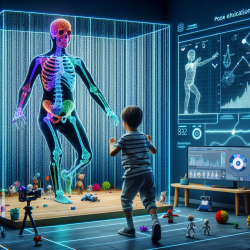Introduction
The field of speech-language pathology is constantly evolving, with new technologies offering innovative ways to enhance therapeutic outcomes. One such advancement is the application of pose estimation technologies, which utilize computer vision to track and analyze human movement from simple video recordings. This blog explores the implications of these technologies for pediatric speech-language pathologists, drawing insights from the research article "Applications of Pose Estimation in Human Health and Performance across the Lifespan."
Understanding Pose Estimation
Pose estimation algorithms identify key landmarks on the human body, such as joints and facial features, using videos captured by common devices like smartphones. This technology allows for the quantitative measurement of movement kinematics, making it accessible and cost-effective for clinical use. By leveraging these tools, speech-language pathologists can gain a deeper understanding of motor development in children, which is often linked to language acquisition and social communication skills.
Applications in Pediatric Speech-Language Pathology
Pose estimation technologies have significant potential in pediatric speech-language pathology, particularly in assessing and monitoring motor development. Here are some key applications:
- Early Detection of Developmental Delays: By analyzing movement patterns, pose estimation can help identify early signs of developmental disorders, such as autism spectrum disorder (ASD) and cerebral palsy (CP), enabling timely intervention.
- Enhancing Therapy Sessions: Therapists can use pose estimation to provide real-time feedback on a child's movements, helping to refine motor skills that are crucial for speech and language development.
- Remote Assessments: With the ability to capture and analyze movement data remotely, pose estimation supports teletherapy models, making therapy more accessible to children in underserved areas.
Encouraging Further Research
While the potential of pose estimation in speech-language pathology is promising, further research is needed to validate its effectiveness and explore new applications. Practitioners are encouraged to collaborate with researchers to develop standardized protocols and contribute to the growing body of evidence supporting these technologies.
Conclusion
Pose estimation technologies offer exciting opportunities to enhance pediatric speech-language pathology by providing objective, quantitative data on motor development. As these tools become more integrated into clinical practice, they hold the potential to improve outcomes for children by enabling early detection of developmental delays and supporting innovative therapy approaches.
To read the original research paper, please follow this link: Applications of Pose Estimation in Human Health and Performance across the Lifespan.










